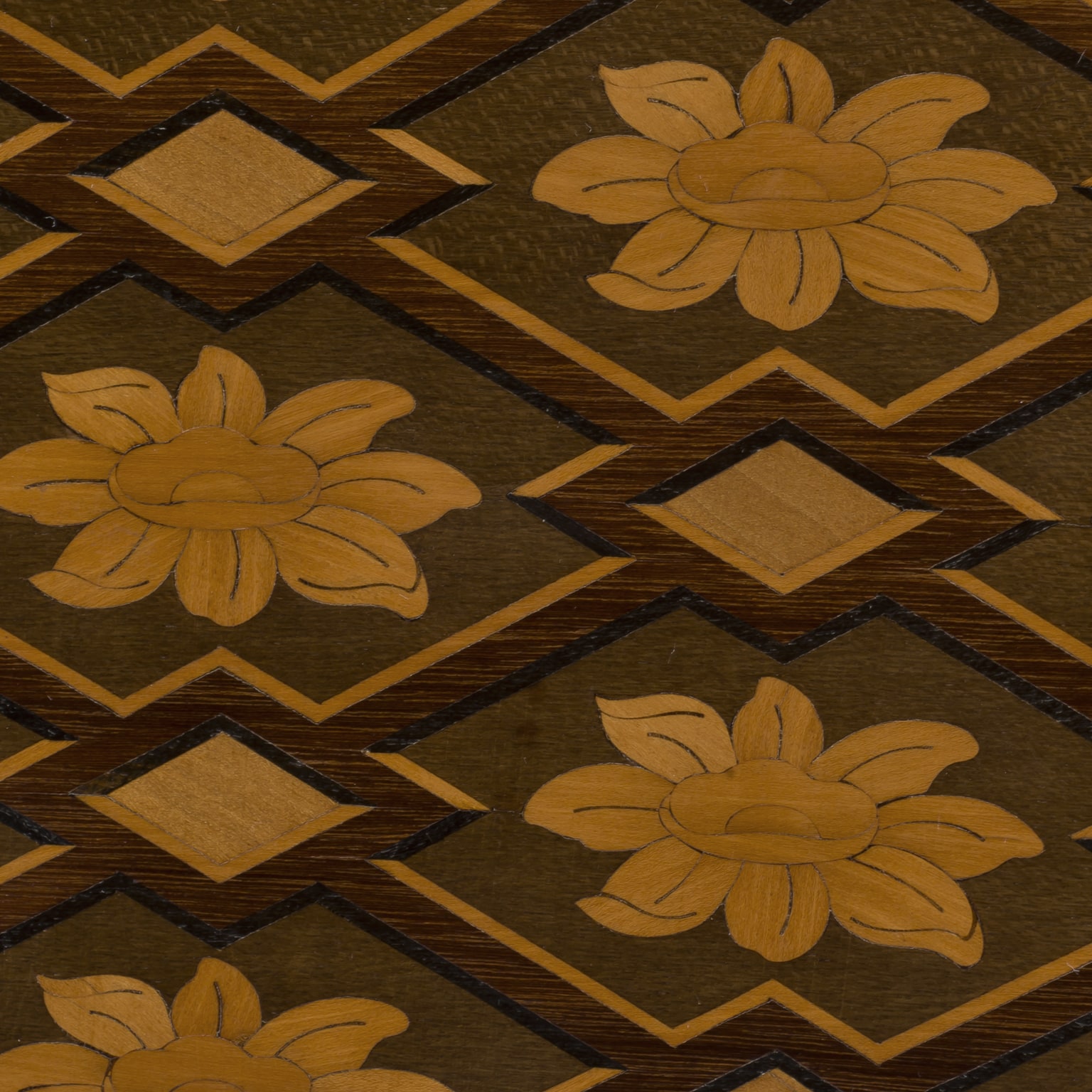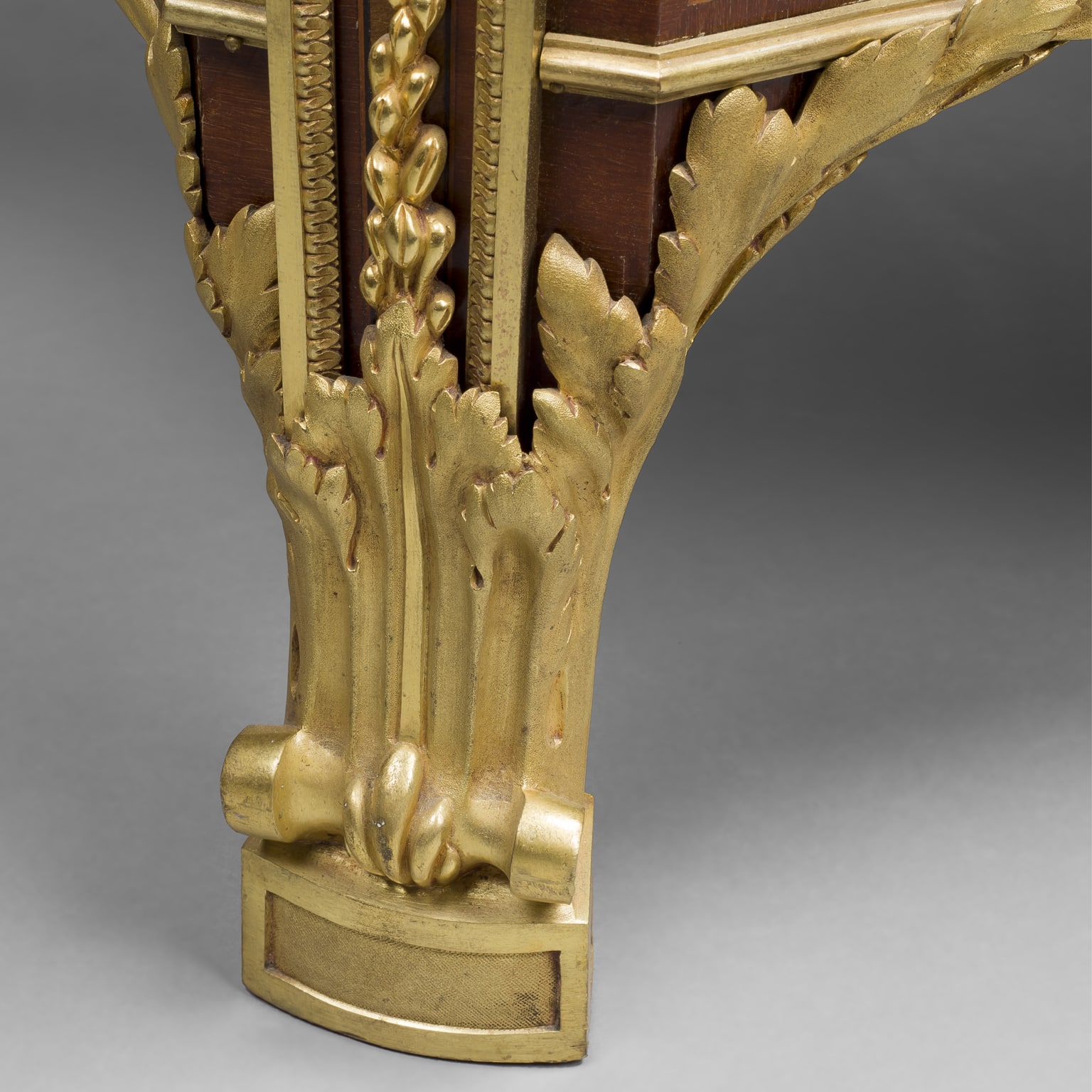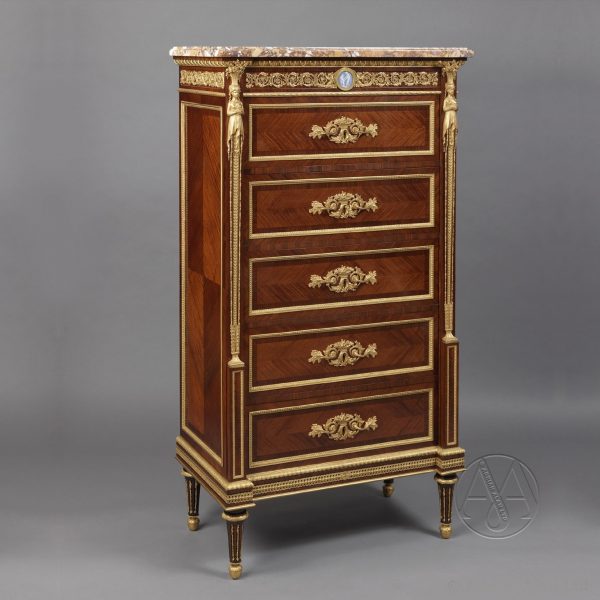François Linke
A Very Fine Louis XVI Style Gilt-Bronze Mounted Marquetry Commode
£85,000
A Very Fine Louis XVI Style Gilt-Bronze Mounted Marquetry Commode after a model by Jean Henri Riesener, By François Linke. Linke Index No. 10. Signed...
Dimensions
Height: 94 cm (38 in)Width: 167 cm (66 in)
Depth: 65 cm (26 in)
Description
A Very Fine Louis XVI Style Gilt-Bronze Mounted Marquetry Commode after a model by Jean Henri Riesener, By François Linke.
Linke Index No. 10.
Signed ‘F. Linke’ and the lock-plate stamped ‘CT LINKE SERRURERIE/PARIS’.
This fine mahogany commode has a fleur de pêcher marble top above a breakfront frieze set with three drawers, over a pair of drawers with a unified central panel of floral marquetry and trophies within a gilt-bronze frame, flanked by panels of foliate parquetry. The apron is mounted with finely cast acanthus and the scroll-mounted legs put down on block feet.
A popular model in Linke’s oeuvre, he produced a number of variations in different sizes, under index numbers 10, 104, 886, 1036 and 1437. Index no. 10 at 170 cm wide being identical to the original Reisener model. Linke purchased a set of patterns for this model of commode from the sale of the ébéniste Cueunières workshop in November 1902 for 209 francs (See C. Payne, p. 205-206). The origin of the design is derived from the cabinet work of the renowned eighteenth century ébéniste de Roi, Jean-Henri Riesener, who was responsible for many important contributions to the formation of the Louis XVI style in France.
The distinctive repetition of stylised rosette and interlaced lattice work marquetry on the present example, punctuated by fine floral marquetry panels and gilt-bronze mounts is redolent of some of the most celebrated examples of his oeuvre.
This commode can be related to two notable commodes namely one made for the bedchamber at Versailles of the Comtesse de Provence, latterly in the music room at Hamilton Palace and now at Waddesdon Manor. Another commode providing direct comparison was the example made for Marie-Antoinette in the 1780’s, and also formerly in the collection of the Duke of Hamilton at Hamilton Palace, now in the Frick Collection. Riesener when describing the identical stylised rosette and interlaced lattice work, as appears on this commode, used on the desk for the comte d’Orsay, talks of ‘mosaic’ marquetry in the taste of Boulle’.
This marquetry equivalent of the inlaid brass and tortoiseshell work of Andre Charles Boulle is derived from almost identical patterns used by Boulle on items such as the impressive Four Continents Clock now in the Wallace Collection. Yet this geometrical device and indeed many other Boulle patterns of the time can be related to Japanese and Chinese lacquer work. For instance the designs employed on the Four Continents Clock are virtually identical to that employed on a lacquer cabinet, now in the Wallace Collection, that was produced for the European Market in Kyoto in around 1680. As time progressed the taste for the oriental became more generalised and interpretations became looser and less dependent on specific original sources.
Date
Circa 1905
Origin
France
Medium
Gilt-Bronze and Marquetry
Signature
Signed 'F. Linke' and the lock-plate stamped 'CT LINKE SERRURERIE/PARIS'.
François Linke (1855 – 1946) was the most important Parisian cabinet maker of the late nineteenth and early twentieth centuries, and possibly the most sought after cabinet maker of his period.
He was born in 1855 in the small village of Pankraz, in what is now the Czech Republic. Records show that Linke served an apprenticeship with the master cabinetmaker Neumann, then in 1875 at the age of 20 he arrived in Paris where he lived until he died in 1946.
It is known that the fledgling Linke workshops were active in Paris in the Faubourg St. Antoine as early as 1881, and during this time he supplied furniture for other more established makers such as Jansen and Krieger.
The quality of Linke’s craftsmanship was unsurpassed by any of his contemporaries and reached its peak with his spectacular stand at the Paris Exposition Universelle in 1900, where his Grand Bureau took the gold medal. He gambled his fortune and reputation on this stand, exhibiting several breathtaking items of furniture with sculptural mounts of the most exceptional quality and proportion. His gamble worked and his reputation was established to such an extent that Linke continued to be the pre-eminent furniture house in Paris until the Second World War.
As the Art Journal reported in 1900 on Linke’s stand:
‘The work of M. Linke … was an example of what can be done by seeking inspiration amongst the classic examples of Louis XV and XVI without in any great sense copying these great works. M. Linke’s work was original in the true sense of the word, and as such commended itself to the intelligent seeker after the really artistic things of the Exhibition. Wonderful talent was employed in producing the magnificent pieces of furniture displayed….’
The formation of Linke’s distinctive style was made possible by his collaboration with the sculptor Léon Messagé. Together Linke and Messagé designed furniture for Linke’s 1900 exhibition stand, with exuberant allegorical figures cast in high relief, that exemplified Linke’s ability to seamlessly merge the different mediums of wood carving, bronze and marquetry into a dynamic unified whole.
Today Linke is best known for the exceptionally high quality of his work, as well as his individualism and inventiveness. All of his work has the finest, most lavish mounts, very often applied to comparatively simple carcasses. The technical brilliance of his work and the artistic change that it represented were never to be repeated.
Bibliography:
Payne, Christopher. François Linke, (1855 – 1946), The Belle Époque of French Furniture, Antique Collectors’ Club, (Woodbridge, UK), 2003.
Meyer, Jonathan. Great Exhibitions – London, New York, Paris, Philadelphia, 1851-1900, Antique Collectors’ Club, (Woodbridge, UK), 2006; pp. 298 – 300.
Ledoux – Lebard, Denise. Les Ébénistes du XIXe siècle, Les Editions de l’Amateur, (Paris), 1984; pp. 439-43.
Revue Artistique & Industrielle, (Paris), July-August 1900.
Coral Thomsen, D. (ed), The Paris Exhibition 1900, The Art Journal, 1901; p.341.















 Print
Print


